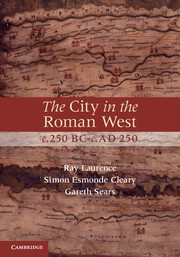Book contents
- Frontmatter
- Contents
- Illustrations
- Preface
- Introduction
- 1 The creation of an urban culture
- 2 Colonisation and the development of Roman urbanism
- 3 City foundation, government and urbanism
- 4 The reception of Roman urbanism in the West
- 5 Town planning, competition and the aesthetics of urbanism
- 6 Defining a new town: walls, streets and temples
- 7 Assembling the city 1: forum and basilica
- 8 Assembling the city 2: baths and urban life
- 9 Assembling the city 3: theatres and sacred space
- 10 Assembling the city 4: amphitheatres
- 11 The Roman city in c. AD 250: an urban legacy of empire?
- Bibliography
- Index
8 - Assembling the city 2: baths and urban life
Published online by Cambridge University Press: 05 June 2012
- Frontmatter
- Contents
- Illustrations
- Preface
- Introduction
- 1 The creation of an urban culture
- 2 Colonisation and the development of Roman urbanism
- 3 City foundation, government and urbanism
- 4 The reception of Roman urbanism in the West
- 5 Town planning, competition and the aesthetics of urbanism
- 6 Defining a new town: walls, streets and temples
- 7 Assembling the city 1: forum and basilica
- 8 Assembling the city 2: baths and urban life
- 9 Assembling the city 3: theatres and sacred space
- 10 Assembling the city 4: amphitheatres
- 11 The Roman city in c. AD 250: an urban legacy of empire?
- Bibliography
- Index
Summary
Within these premises of Aurelia Faustiniana is a bath; you can bathe here in the manner of the capital and every refinement (humanitas) is available.
(Ficulea, Italy CIL 14.4015)Bath-buildings are one of the commonest types of building in Roman cities, more common indeed than all other classes of urban building apart from houses. Furthermore, across the western provinces and North Africa they are to be found in all sorts of settlements, be they forts, villas or lesser towns; with the result that they are one of the most recognisable of Roman building types and could be said to be as characteristic of Roman-style living as any of the more famous markers of the Roman presence such as forts, towns or villas. Their ubiquity and their presence at such a wide range of places should make it clear that baths and bathing were intimately linked to becoming and being Roman; by the same token, not to have baths or not to have ready access to them suggests a level of disengagement from Roman-style practices. Yet despite the importance of bathing proclaimed by this ubiquity, bathhouses have until recently been rather the poor relations of other building-types in the attention paid to them by modern scholars. In part, this is probably because, at a very simple level bath-buildings seem self-explanatory. From the simplest to the grandest, they all display the same essential features. There was a suite of three rooms of varying temperatures: the frigidarium (cold room), tepidarium (warm room) and caldarium (hot room), the last two heated by underfloor hypocausts and provided with basins for water to humidify the air. In these the bather got progressively hotter so that the pores opened and the sweat carried away dirt, and cleaning was aided by scraping the skin with a curved strigil and by rubbing in oils. This would be all that the simplest type of bath-suite – what the German tradition calls Reihentyp (row type) – would provide for.
- Type
- Chapter
- Information
- The City in the Roman West, c.250 BC–c.AD 250 , pp. 203 - 230Publisher: Cambridge University PressPrint publication year: 2011

